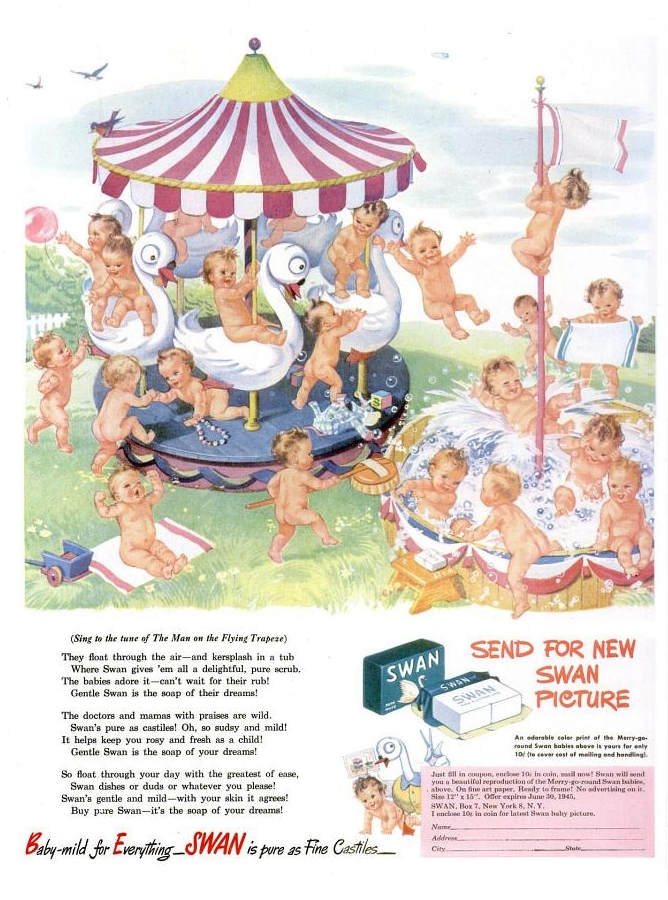Swan Soap on:
[Wikipedia]
[Google]
[Amazon]
 Swan was a
Swan was a
105; 124; 371
{{cite book , last1=Winn , first1=J. Emmett , last2=Brinson , first2=Susan L. , title=Transmitting the Past: Historical and Cultural Perspectives on Broadcasting , url=https://books.google.com/books?id=-_Ugz8LozusC&pg=PA146 , year=2005 , publisher=University of Alabama Press , isbn=978-0-8173-5175-5 , pages=140; 146 {{cite court , litigants=Lever Bros. Co. v. Procter & Gamble Mfg. Co. , vol=139 , reporter=F.2d , opinion=633 , pinpoint= , court=4th Cir. , date=December 28, 1943 , url=http://law.justia.com/cases/federal/appellate-courts/F2/139/633/1568047/ , accessdate=2015-02-04 {{cite news , last=Peale , first=Cliff , title=Corporate Espionage Has Long History , date=September 9, 2001 , newspaper=The Cincinnati Enquirer , url=http://www.enquirer.com/editions/2001/09/09/fin_corporate_espionage.html , accessdate=2015-02-04 {{cite web , url=https://casetext.com/case/young-v-lever-brothers-company , year=1973, title=Young vs. Lever Brothers Soap brands
brand
A brand is a name, term, design, symbol or any other feature that distinguishes one seller's good or service from those of other sellers. Brands are used in business, marketing, and advertising for recognition and, importantly, to create ...
of soap
Soap is a salt of a fatty acid used in a variety of cleansing and lubricating products. In a domestic setting, soaps are surfactants usually used for washing, bathing, and other types of housekeeping. In industrial settings, soaps are use ...
introduced by the Lever Brothers
Lever Brothers was a British manufacturing company founded in 1885 by two brothers: William Hesketh Lever, 1st Viscount Leverhulme (1851–1925), and James Darcy Lever (1854–1916). They invested in and successfully promoted a new soap-making p ...
Company in 1941 to compete with Ivory
Ivory is a hard, white material from the tusks (traditionally from elephants) and teeth of animals, that consists mainly of dentine, one of the physical structures of teeth and tusks. The chemical structure of the teeth and tusks of mammals i ...
. Swan may have been advertised as a soap that could be used in the kitchen as a hand soap or in the bathroom to bathe the baby. Actually, during the radio show My Friend Irma, it was specifically promoted as a dish soap.
Swan, like Ivory, was a floating soap, but Lever had developed and patented a new manufacturing method that both streamlined the process and resulted in a finer product more like milled soap. A typical advertisement boasted that Swan was "the white floating soap that's purer than the finest castiles". Lever and Procter & Gamble became embroiled in litigation over the process and products of it. Lever sued Procter & Gamble for patent infringement after the format of Ivory changed; the Appellate Court found that the patent had been infringed and Procter & Gamble were required to pay $5.675 million to Lever.
Lever Brothers used the Swan brand name to sponsor several radio programs, notably ''The George Burns and Gracie Allen Show
''The George Burns and Gracie Allen Show'', sometimes called ''The Burns and Allen Show'', was a half-hour television situation comedy broadcast from 1950 to 1958 on CBS. It starred George Burns and Gracie Allen, one of the most enduring acts in ...
'' (1941–1945), '' Joanie's Tea Room'' (1945–1947), ''The Bob Hope Show
''The Pepsodent Show'' is an American radio comedy program broadcast during the Golden Age of Radio. The program starred comedian Bob Hope and his sidekick Jerry Colonna along with Blanche Stewart and Elvia Allman as high-society crazies Brenda a ...
'' (1948–1949), and ''My Friend Irma
''My Friend Irma'' is a media franchise that was spawned by a top-rated, long-running radio situation comedy created by writer-director-producer Cy Howard. The radio show was so popular in the late 1940s that its success escalated the films, ...
'' (1947–1951).
Swan's print ads were colorful works of art, and often featured children, babies, soapsuds and, of course, a swan. Some people had the Swan soap ad prints displayed on their wall at home. The art prints were made available to the public as promotional items by the company.
Swan Soap is no longer marketed.
Lawsuits
In 1972, Gladys Young sued the manufacturer of Swan liquid dishwashing detergent, Lever Brothers, and the manufacturer's insurer for damages because of skin irritation allegedly caused by her use of the product between 1968-70. She testified that a week or two after she started using Swan, the detergent dried out her fingers and they began to itch around the nails. When her nails began to recede within two or three months, Mrs. Young reflected upon the cause and theorized that the change to Swan could have been responsible for the condition.
The district court dismissed her suit after a trial on the merits on September 26, 1973. However, publicity from the trial hurt sales and Swan Detergent was discontinued by 1974.
References
{{reflist, refs= {{cite book , last=Aaker , first=David A. , title=Managing Brand Equity , url=https://books.google.com/books?id=r_TSY5sxnO8C&pg=PT19 , year=2009 , publisher=Simon and Schuster , isbn=978-1-4391-8838-5 , page=19 {{cite book , last=Dunning , first=John , title=On the Air: The Encyclopedia of Old-Time Radio , url=https://archive.org/details/onairencyclop00dunn/page/105 , url-access=registration , year=1998 , publisher=Oxford University Press , isbn=978-0-19-507678-3 , page105; 124; 371
{{cite book , last1=Winn , first1=J. Emmett , last2=Brinson , first2=Susan L. , title=Transmitting the Past: Historical and Cultural Perspectives on Broadcasting , url=https://books.google.com/books?id=-_Ugz8LozusC&pg=PA146 , year=2005 , publisher=University of Alabama Press , isbn=978-0-8173-5175-5 , pages=140; 146 {{cite court , litigants=Lever Bros. Co. v. Procter & Gamble Mfg. Co. , vol=139 , reporter=F.2d , opinion=633 , pinpoint= , court=4th Cir. , date=December 28, 1943 , url=http://law.justia.com/cases/federal/appellate-courts/F2/139/633/1568047/ , accessdate=2015-02-04 {{cite news , last=Peale , first=Cliff , title=Corporate Espionage Has Long History , date=September 9, 2001 , newspaper=The Cincinnati Enquirer , url=http://www.enquirer.com/editions/2001/09/09/fin_corporate_espionage.html , accessdate=2015-02-04 {{cite web , url=https://casetext.com/case/young-v-lever-brothers-company , year=1973, title=Young vs. Lever Brothers Soap brands